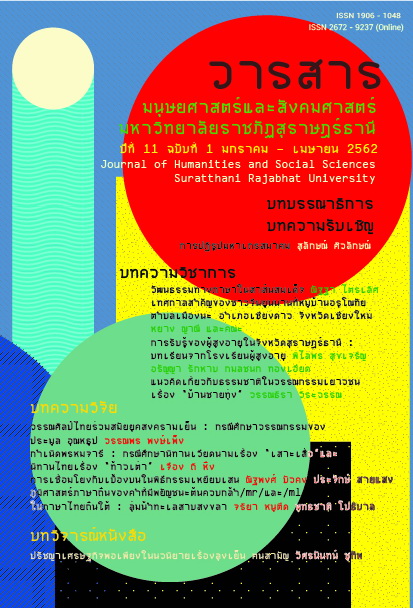Contemporary Thai literary style in the period of Cold War: A Case study of Pramun Aunha-Thup’s literary works
Main Article Content
Abstract
This study analyzes the characteristics that define the literary style pioneered by Pra-mun Aunha-thup, one of Thailand's greatest contemporary writers. His unconventional use of Thai grammar, combined with a style that seamlessly fused newspaper journalism and traditional descriptive writing together created a unique prose writing style that illuminates both hisconsiderable talents as a writer and the turbulent cold war period in Thailand in which he lived and worked. During this time, a period marked by great ideological differences, modernization, urbanization and industrialization in Thai society and the influence that the West brought to bear through Hollywood movies and translated literary works, Pra-mun Aunha-thup's literary style heralded the advent of Thai literature in a modern context.
Article Details

This work is licensed under a Creative Commons Attribution-NonCommercial-NoDerivatives 4.0 International License.
All published manuscripts have been verified by peer-peer professors in the fields of humanities and social sciences. Reprinting of the article must be authorized by the editorial staff.
References
Andrew Roos. (1989). No Respect: Intellectuals and Popular Culture. London: Routledge.
Arthit Jiamrattanyu. (2015). “Filipino Students” in the eyes of Thai elite scholars toward aboard students before Greater East Asia War period. ‘Chum-thang Indochina’: Journal of Southeast Asian. 4(7), 572. (In Thai)
Arthit Jiamrattanyu. (2017, May - August). From “Sod” to “Swing”: Occidentalism and the politics of cultural translation in modern Thailand. Political Science Journal. 38(2), 73-130 . (In Thai)
Chan-chai Saekuay. (1987). Unconventional diction in Rong Wongsawan's works. Master’s Thesis. [Online]. Retrieved from http://newtdc.thailis.or.th/result.aspx. [2019, July 5]. (In Thai)
Chao-jam-pee (pseud.). (1967). ‘Pok-ha’ Club and ‘Rock’n Roll literature. Phra Nakon: Ruamsan. (In Thai)
Chao-jam-pee (pseud.). (1971). Mae Sri Aey. Phra Nakon: Bannakarn. (In Thai)
Chatcharin Chaiwat. (2009, September 27). [Online]. The Intelligence power. Retrieved from https://www.thaipost.net/main/ [2017,
November 15]. (In Thai)
Chonlada Ruenruglikit. (1984). An analytical of orthography and language usage of Humourist. Bangkok: Chulalongkorn University. (In Thai)
Dhanate Vespada. (2006). Hom Lok Vannasilp: The creation of Thai Literature Aesthetics. Bangkok: Pajera. (In Thai)
Dome Sukwongse and Sawat Suwannapak. (2002). The 100 years of Thai Films. Bangkok. River Books. (In Thai)
Maneepin Phromsuthirak; et al. (1990). The Development of Thai Literature Unit 1-7 (3rded.). Nonthaburi: Sukhothaithammathirat. (In Thai)
Nidhi Aeusrivongse. (2018). The influences of American in Thailand. [Online]. Retrieved from https://www.matichon.co.th/columnists/
news_1102040 [2018, October 18]. (In Thai)
Pramun Unhathup. (1969). Phru-kwang Thang Sawan Lae Na-rok. Phra Nakorn: Praphansarn. (In Thai)
Pramun Unhathup. (1969). Rue Ja Rert Rommayet. Phra Nakorn: Praphansarn. (In Thai)
Pramun Unhathup. (1969). Sareong Ra-bam Dam-roo. Phra Nakorn: Praphansarn. (In Thai)
Pramun Unhathup. (1969). Sepsom Bo Mi Som. Phra Nakorn: Praphansarn. (In Thai)
Pramun Unhathup. (1970). Thang-horadee Khong Himmavana. Phra Nakorn: Praphansarn. (In Thai)
Pramun Unhathup. (1970). Trap-duen-tawan Fanfa Lae Din. Phra Nakorn: Praphansarn. (In Thai)
Pramun Unhathup. (1991). Dokrak. Bangkok: Matichon. (In Thai)
Pramun Unhathup. (2001). Ruang khong Chan Dara. Bangkok: Matichon. (In Thai)
Pramun Unhathup. (2002). Chor Prayong. Bangkok: Matichon. (In Thai)
Pramun Unhathup. (2002). Kamket. Bangkok: Matichon. (In Thai)
Soranat Tailanga. (2014, January-June). Gender and Sexuality in Modernism Aspect: A Case Study of Fuang Nakorn short stories by ‘Rong-Wong-Savan and Puan Noom. Journal of Social Sciences and Humanities of Songklanakarin University Pattani CampusVol. 10(1), 9-49. (In Thai)
Suchada Chareonnit. (2011). Comparison of word use and grammatical patterns in English advertising headlines in Thai-English and English Magazines, Academic. Journal of Thai Chamber University. 31(1), 80-94. (In Thai)
Suchitra Chongstitvattana. (2005). Jerm-jan Kangsadan: Literary language in Thai Literature. Bangkok: The project of academic writings
publication of Faculty of Arts Chulalongkorn University. (In Thai)
Supawadee Supraditarporn. (2007). Problems in the Interpretation of Advertising Discourses. Master’s Thesis. [Online]. Retrieved from http://newtdc.thailis.or.th/docview.aspx?tdcid=268359. [2019, February 11]. (In Thai)
Thakeong Amornphan. (n.d.). Language in newspaper. [Online]. Retrieved from http://dspace.nstru.ac.th:8080/dspace/bitstream [2019, February 26]. (In Thai)
The Memorial Book of Wit Sutthasathian. (1990). Bangkok: Dansuttha. (In Thai)
Udom Srisuwan. (2017). Set Nue Khang Kiang. Matichon Weekly. 37(1938) pp.74.
Vidhyakorn Chiangkoon. (1993). Why “do I search for meaning” Life Work and Opinion of Vidhyakorn Chiangkoon. Bangkok: Grammy
Publishing House. (In Thai)
Vidhya Sutjaritthanarak. (2014). Southeast Asia after the period of Cold War. Plamplet of Security Studies. (141-142), p.1. (In Thai)
Working Group Members of the History of Thai Printings. (2006). Siam-Pimpakan: The History of printing in Thailand. Bangkok: Matichon. (In Thai)


